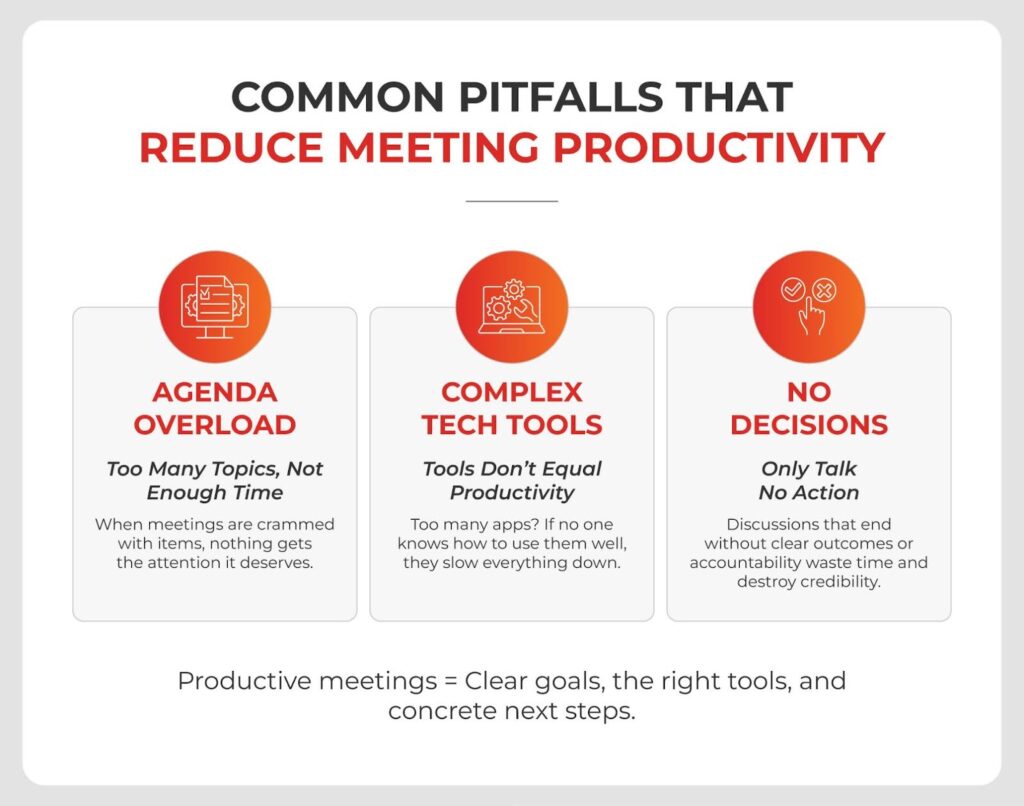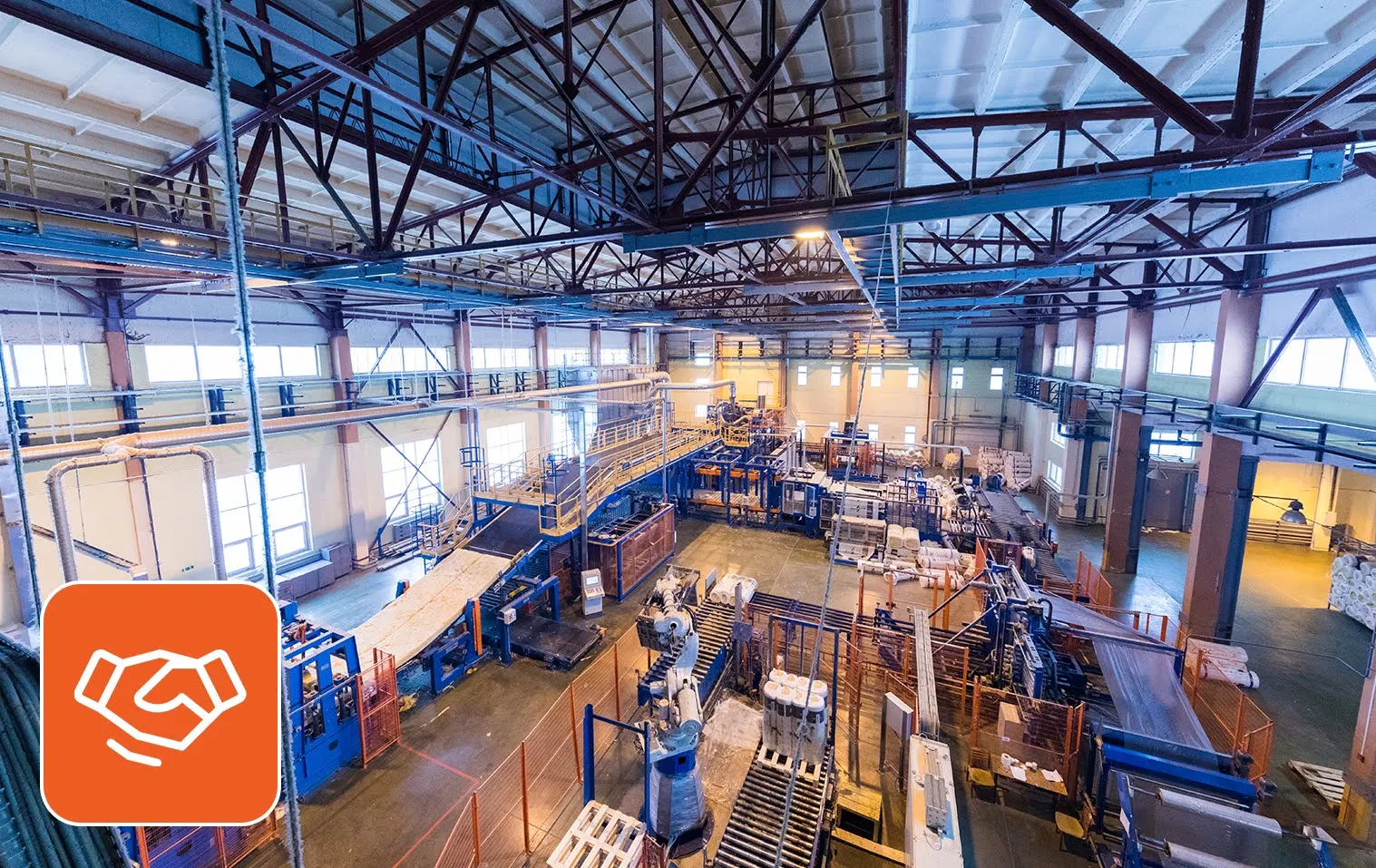Meetings are the engine rooms of organizations. Done right, they align strategy, accelerate decision-making, and build accountability. Done wrong, they drain energy and slow execution. As one HR leader once said, “The costliest room in our company isn’t the boardroom, it’s the weekly check-in where twelve people spend an hour without moving the needle.”
If you’ve ever calculated the real cost of a meeting, salary per hour multiplied by the number of people in the room, you’ll know why meeting productivity deserves more scrutiny than it often gets. The question is not whether to have meetings, but how to make meetings productive so they serve as catalysts rather than bottlenecks.
Below are three evidence-backed steps that can help you rewire how you run meetings and drive output that sticks.
Step 1: Redesign the Purpose and Structure
Too often, meetings exist by default rather than design. A recurring slot gets created, agendas blur, and participants walk in unclear about outcomes. The fix is deceptively simple: clarify the “why” before the “when.”
Think of every meeting as an investment pitch. Would you fund it if it didn’t promise returns? That’s the mindset leaders need. The structure must match the purpose.
- If the goal is decision-making, use frameworks like RAPID or RACI to clarify roles.
- If the goal is information-sharing, ask if a written memo or asynchronous update would achieve the same.
- If the goal is problem-solving, limit participants to those who can influence the solution.
This level of discipline naturally feeds into effective meeting strategies. It reduces overlap, eliminates unnecessary invitations, and enables employees to prepare meaningfully.
And the data backs this up. In a study of 76 organizations that introduced meeting-free days, nearly half cut back on meetings by about 40% through tighter design and scheduling. The outcome wasn’t just fewer calendar blocks; it translated into productivity gains of more than 70%, proving that intentionality pays real dividends.
For distributed teams, the same discipline extends to effective virtual meeting strategies. A hybrid meeting with unclear goals can quickly dissolve into dead air, while one with tight objectives and time-bound slots can create energy across time zones.
Also read: The Future of Remote Work: How to Adapt with AI & Cybersecurity?
Step 2: Engineer Engagement Through Design
A meeting isn’t a lecture. If participants are passive, productivity evaporates. To make a meeting genuinely effective, leaders must engineer engagement rather than expect it to appear organically.
Here’s where productive meeting tips become practical:
- Front-load context – Share pre-reads or a one-page summary 24 hours before. It allows participants to arrive at the same baseline.
- Rotate facilitators – Shifting facilitation duties keeps energy high and prevents hierarchy from silencing input.
- Apply the two-pizza rule – If the group is too large to feed with two pizzas, it’s too large to be effective.
Some organizations have started reframing weekly team syncs as “design sprints.” Each sprint focuses on a specific deliverable, and participants leave with concrete action steps.
Even in high-stakes executive settings, design matters. The best boards use effective team meeting strategies like allocating a fixed time for dissent before converging on consensus. This avoids groupthink and ensures that decisions reflect diverse perspectives rather than just the loudest voices.
Step 3: Translate Time Spent into Outcomes
The final test of a meeting’s value is not how smoothly it ran but whether it moved work forward. Too many meetings end with “great discussion” but no execution trail. To avoid this and improve productivity in a meeting, leaders must create explicit bridges from conversation to action.
That means:
- Closing with clear next steps, owners, and timelines.
- Capturing agreements in collaborative tools rather than someone’s private notebook.
- Following up at the start of the next session with a progress check.
When meetings consistently close with actionable clarity, they become investments with compound interest.
Beyond the Three Steps: Practical Levers for Everyday Use
While the three steps above are the pillars, small tactical levers can elevate everyday execution. Consider these:
- Use a visible countdown clock in virtual calls to maintain meeting efficiency.
- Begin with a “red team” question: What would make this meeting a waste of time? Then actively avoid those traps.
- For global teams, rotate time slots to distribute the inconvenience fairly.
These are nudges that reframe meetings as assets rather than obligations. Leaders who adopt them demonstrate respect for their colleagues’ time, arguably the rarest resource in today’s workplace. Doing so, thus, helps improve employee morale and engagement.
Common Pitfalls to Avoid

Even seasoned leaders fall into traps when trying to improve meeting productivity. Watch out for these:
- Agenda overload – Packing 12 items into a 30-minute slot guarantees superficiality.
- Technology overcomplication – Fancy collaboration tools that participants don’t know how to use slow things down.
- Absence of closure – Discussions without decisions erode credibility.
To Conclude: Rethink Meetings as a Strategic Resource
The temptation is to see meetings as inevitable overhead. But organizations that thrive flip the script: they treat meetings as a strategic resource, carefully invested and relentlessly measured.
For HR and TA leaders, this perspective is especially powerful. The meeting is where culture gets tested in real time. A dysfunctional meeting signals weak accountability; a disciplined one signals operational maturity.
So the challenge isn’t only about making meetings more productive. It’s about positioning them as catalysts of organizational alignment. Imagine meetings as a refinery: raw ideas and debates go in, distilled clarity and execution plans come out. The waste is minimized, and the output fuels growth.
And here lies the overlooked insight: improving meetings doesn’t just save time. It improves employee experience, reduces burnout, and strengthens trust. When people feel their time is valued, they give more of their best selves to the work.
The next time you walk into a room or log onto a call, ask yourself: Is this meeting a refinery or a landfill? The answer will define not just the productivity of that hour, but the health of your entire organization.
Ready to transform not just your workforce, but the way your teams work together? At SPECTRAFORCE, we bring human-centric staffing solutions that align talent, technology, and culture, so your meetings (and your business) run with purpose. Discover SPECTRAFORCE.
FAQs
Meetings can be made more efficient by first clarifying why the meeting is being held and what outcome is expected. Efficiency also comes from preparing a focused agenda, sharing materials in advance, and ensuring only the people who are directly involved are invited. When discussions are time-boxed and decisions are documented, meetings feel sharper and more valuable.
Productive meeting tips include keeping the meeting purpose clear, using pre-reads to save time, and creating space for active participation. Another helpful tip is to rotate facilitators so that no single person dominates the conversation and everyone feels a sense of ownership. Ending the meeting with an action list that includes names and deadlines ensures that the time spent yields results as well.
A productive meeting is achieved by defining the goal in advance and making sure the structure supports it. For example, if the goal is to make a decision, then the meeting should focus on narrowing options and agreeing on the final choice. If the goal is to share information, then it might be more productive to send an update memo instead. A meeting becomes truly productive when participants leave knowing what was achieved and what comes next.
Effective meeting strategies are approaches that make conversations purposeful and results-oriented. These include matching the meeting type to the goal, keeping the group small enough to encourage real discussion, and ensuring every decision has a clear owner. In virtual or hybrid environments, effective strategies also mean shorter sessions, stronger moderation, and the use of simple tools that do not distract from the conversation.
Meetings can be made more productive by treating time as a scarce resource and designing every session to create value. This means removing unnecessary agenda items, avoiding long-winded updates, and focusing instead on problem-solving and decision-making. When meetings are designed this way, participants walk out feeling their time was respected, and the organization benefits from faster progress.



